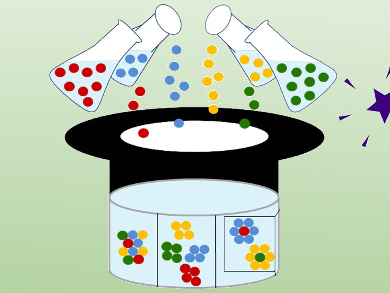A key feature of biological systems is their ability to assemble structures and functioning entities from multiple building blocks (social self-assembly, pictured bottom left). Alternatively, they can form systems in which different building blocks form separate structures in a self-sorting fashion (asocially, pictured bottom center). There has been a profound interest in mimicking this behavior in synthetic self-assembling systems.
Andreas Walther, University of Freiburg, Germany, and colleagues have developed colloidal multicomponent systems incorporating up to four partners (four colors in picture). Controlled interactions between the particles can be used to socially self-sort four partners into two co-assembled families (pictured bottom right).
The team prepared core/shell microgel colloids equipped with cyclodextrin recognition motifs. The cores consist of poly(trifluoroethyl methacrylate) (PtFM) labeled with different fluorophores and the shells consist of N-isopropylacrylamide (NIPAM), N,N′-methylenebisacrylamide, and acrylic acid. The cyclodextrin host-guest pairs used are α-CD/azobenzene and β-CD/ferrocene. They provide a lock-and-key system for sorting the particles.
Colloidal systems have the advantage of being observable by optical microscopy in real time. The imaging data reveal the switchability of the co-assembled families. According to the researchers, the future success in this field will, on one hand, rely on finding approaches to use these concepts for materials (e.g., for self-healing gels), and on the other hand on diversifying their system behavior towards increasing complexity. This includes, in particular, the implementation of possibilities for signaling between the entities and families so that they can reconfigure on demand and lead to vastly different properties.
- Social Self-Sorting of Colloidal Families in Co-Assembling Microgel Systems,
Kang Han, Dennis Go, Thomas Tigges, Khosrow Rahimi, Alexander J. C. Kuehne, Andreas Walther,
Angew. Chem. Int. Ed. 2017.
DOI: 10.1002/anie.201612196
